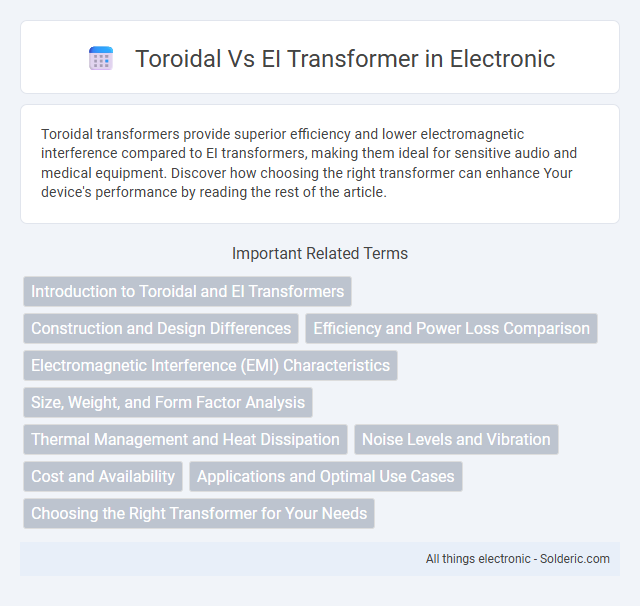Toroidal transformers provide superior efficiency and lower electromagnetic interference compared to EI transformers, making them ideal for sensitive audio and medical equipment. Discover how choosing the right transformer can enhance Your device's performance by reading the rest of the article.
Comparison Table
| Feature | Toroidal Transformer | EI Transformer |
|---|---|---|
| Core Shape | Doughnut-shaped (Toroid) | EI-shaped laminated core |
| Magnetic Flux | Closed-loop, minimal leakage | Flux leakage at gap junctions |
| Efficiency | High, typically 95-98% | Moderate, around 90-95% |
| Size & Weight | Compact and lightweight | Larger and heavier |
| Noise Level | Low hum and vibration | Noticeable hum due to magnetostriction |
| Cost | Generally higher due to complex winding | Lower production cost |
| Applications | Audio equipment, medical devices, precision instruments | Power supplies, industrial equipment |
| Manufacturing Complexity | High, involves precise winding | Relatively simple assembly |
| Thermal Performance | Better heat dissipation due to core design | Moderate heat handling |
Introduction to Toroidal and EI Transformers
Toroidal transformers feature a doughnut-shaped core composed of a continuous strip of grain-oriented silicon steel, enhancing magnetic flux efficiency and reducing electromagnetic interference. EI transformers possess E-shaped and I-shaped laminated cores that facilitate easier winding and assembly but tend to exhibit higher electromagnetic noise and stray magnetic fields. Both transformer types serve distinct applications in electrical devices, with toroidal models favored for compactness and low noise, while EI transformers are commonly used in cost-sensitive and general-purpose scenarios.
Construction and Design Differences
Toroidal transformers feature a doughnut-shaped core made from a continuous strip of silicon steel, which reduces core losses and electromagnetic interference compared to EI transformers, which use laminated E and I-shaped steel sheets stacked to form the core. The compact design of toroidal transformers allows for fewer windings and a smaller footprint, while EI transformers have a bulkier structure due to their layered assembly. The winding technique in toroidal transformers involves wrapping wire evenly around the ring-shaped core, enhancing magnetic flux efficiency, whereas EI transformers use separate bobbins for primary and secondary windings on the stacked laminations.
Efficiency and Power Loss Comparison
Toroidal transformers exhibit higher efficiency than EI transformers due to their continuous core design, which minimizes magnetic flux leakage and reduces core losses. EI transformers have increased power loss caused by air gaps in their laminated cores, leading to greater hysteresis and eddy current losses. The compact and circular structure of toroidal transformers contributes to lower copper losses and improved heat dissipation, making them more energy-efficient in various electrical applications.
Electromagnetic Interference (EMI) Characteristics
Toroidal transformers exhibit lower Electromagnetic Interference (EMI) due to their closed-loop core design, which confines magnetic flux and reduces stray emissions. In contrast, EI transformers have an open core structure that allows more magnetic leakage, resulting in higher EMI levels. This difference makes toroidal transformers preferable in sensitive electronic applications demanding minimal electromagnetic disturbance.
Size, Weight, and Form Factor Analysis
Toroidal transformers feature a compact, doughnut-shaped core that significantly reduces size and weight compared to traditional EI transformers, making them ideal for applications with limited space. EI transformers use laminated silicon steel cores with a rectangular shape, resulting in bulkier dimensions and heavier weight, which can impact form factor flexibility. Your choice depends on whether you prioritize space-saving efficiency or cost-focused design in transformer applications.
Thermal Management and Heat Dissipation
Toroidal transformers feature a compact core design with superior thermal conductivity, allowing for efficient heat dissipation and lower operating temperatures due to their continuous magnetic circuit and minimal core losses. In contrast, EI transformers, with their laminated core structure, tend to generate more heat concentrated at core joints, requiring additional cooling measures such as larger ventilation gaps or heat sinks for effective thermal management. Effective heat dissipation in toroidal transformers leads to enhanced reliability and longer lifespan, making them preferable for applications where thermal efficiency is critical.
Noise Levels and Vibration
Toroidal transformers exhibit significantly lower noise levels and vibration due to their symmetrical circular core design, which reduces mechanical hum and electromagnetic interference. In contrast, EI transformers often produce higher audible hum and vibrations because of their laminated E and I core structure, which generates more mechanical stress and magnetic flux leakage. The superior noise performance of toroidal transformers makes them ideal for audio equipment, medical devices, and sensitive electronic applications.
Cost and Availability
Toroidal transformers typically have a higher initial cost due to their complex manufacturing process and specialized copper windings, but their efficiency and compact size can lead to long-term savings. EI transformers are generally more affordable and widely available, benefiting from mass production and simpler construction, making them a cost-effective option for many applications. Supply chain disruptions can affect both types, but EI transformers tend to have better availability due to standardized designs and broader industry use.
Applications and Optimal Use Cases
Toroidal transformers excel in audio equipment and medical devices due to their low electromagnetic interference and compact size, making them ideal for sensitive electronics and space-constrained environments. EI transformers are preferred in power supplies and household appliances because of their robust construction and cost-effectiveness for handling higher voltages and currents. Optimal use cases for toroidal transformers involve scenarios requiring minimal noise and efficient energy transfer, while EI transformers are suited for general power distribution and industrial applications.
Choosing the Right Transformer for Your Needs
Selecting the right transformer requires evaluating efficiency, size, and electromagnetic interference. Toroidal transformers offer superior energy efficiency, compact design, and minimal electromagnetic noise, making them ideal for sensitive electronics and audio equipment. EI transformers, while bulkier and less efficient, provide easier mounting and cost-effectiveness suitable for general-purpose applications and rugged environments.
Toroidal vs EI Transformer Infographic

 solderic.com
solderic.com